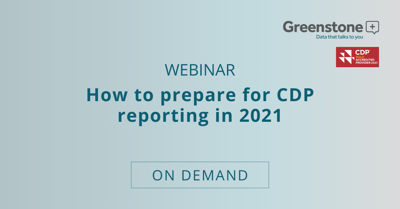CDP 2020 climate change questionnaire - changes for the financial services sector
 CDP have released their 2020 questionnaire on Climate Change, aimed at helping companies to disclose their current emissions and actions around climate change mitigation and adaptation. The deadline for submission has been extended in light of COVID-19 to 26 August 2020 and the Online Response System (ORS) is now open for users to start entering their information.
CDP have released their 2020 questionnaire on Climate Change, aimed at helping companies to disclose their current emissions and actions around climate change mitigation and adaptation. The deadline for submission has been extended in light of COVID-19 to 26 August 2020 and the Online Response System (ORS) is now open for users to start entering their information.
Greenstone, a gold CDP accredited provider, is helping numerous clients this year with their CDP submissions. With in-depth knowledge of the CDP reporting system, our team of industry experts work closely with our clients through the whole reporting process to ensure they submit a robust, clear and complete CDP response.
In this article, we will discuss the key changes to the 2020 questionnaire to be aware of for the financial services (FS) sector and provide suggestions for those wishing to improve on their scores.
General changes
80% of the questions in this year’s questionnaire have had either no changes or minor changes, with 4 new general questions and 19 modified questions. However, there have been a number of changes to CDP’s sector-focused questions, most notably to the financial services sector, with the inclusion 27 new questions and the removal of 23 questions which are discussed in further detail below.
This year CDP has also aligned itself more closely with the recommendations from the Taskforce on Climate-related Financial Disclosure (TCFD), ensuring that companies responding to CDP can easily integrate information from the recommendations, particularly on climate-related risks and opportunities.
Changes for the financial services sector
The sector-specific questions for financial services are targeted at listed companies with operations that fall into one of the following CDP groups:
- Banking (Lending)
- Insurance (Underwriting)
- Asset management (Investing)
- Asset ownership (Investing)
Previous CDP responses were operationally focused. However, this year CDP has drawn further on the TCFD recommendations, which highlighted the importance of indirect financing impacts, since the majority of emissions associated with the financial services sector occur in the investment chain. CDP has introduced a new module (C 14) on portfolio impact and have shifted from an internal to an external focus. This means that for the first time, companies are required to disclose on the Scope 3 emissions of their portfolios at a granular level instead of measuring emissions associated with only their own operations.
| FS new question disclosure focus |
|
The new questions cover mostly qualitative indicators around governance and board oversight of climate related issues in financing activities, climate related risks and opportunities within financial products and services offered, and how these considerations impact business strategy and engagement with clients as well as with investee companies.
There are also questions on quantitative indicators around Scope 3 (GHG Category 15) investment emission and other portfolio impact metrics. The questions focus on financial institutions’ financing activities, cover lending, investment, and underwriting portfolios, including different financial asset class and sector exposure where appropriate. CDP has recognised that there is no single, globally approved methodology for measuring portfolio impact that applies to all financial services sector companies and all financing activities, therefore the new questions allow disclosers to express their portfolio impact in several metrics.
23 questions have also been removed from the FS sector within the following modules:
- C6 Emissions
- C7 Emissions breakdowns (Scope 1 & 2)
- C8 Energy
- C11 Internal carbon pricing
This means that companies no longer have to disclose the breakdown of their own emissions to CDP, although this will likely still be a regulatory requirement for most companies. This is an interesting change as all other sectors are still required to make this disclosure, but is perhaps aimed at alleviating reporting fatigue for the financial sector and shifting the focus to the areas which can make the most positive impact.
Next steps
The intention of CDP is to create a “positive feedback loop” by encouraging the financial sector to obtain relevant information from their clients and investee companies, in the hopes that this will lead to improved disclosure from those respective companies and improved data availability system-wide.
The new questions surrounding portfolio impact will be particularly challenging for companies in this year’s submission as most companies are unlikely to have such granular information on their portfolios. Most disclosers are therefore expected to only be able to partially complete this section, and CDP will be taking a light touch approach to scoring this year. More information on scoring is available here.
With the measurement of portfolio impact being such a key focus for CDP submissions, our top tip would be to start collecting data on portfolio impact. Through Greenstone’s InvestorPortal software users can customise the platform to focus on their respective portfolios and measure the impact through qualitative and quantitate assessments, in line with the CDP questionnaire and the TCFD recommendations.
Discover the latest news and stay up to date with all the changes regarding CDP disclosure.
For more information on CDP reporting and measuring your portfolio impact, please contact the Greenstone team.
On-Demand Webinar | How to prepare for CDP reporting in 2021










